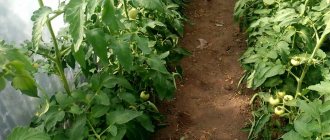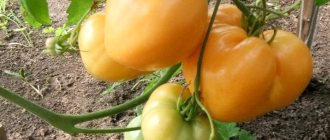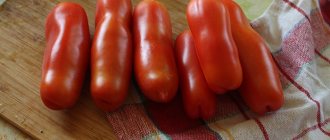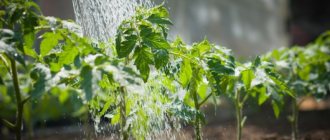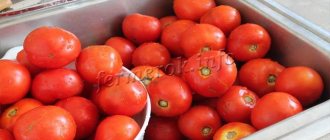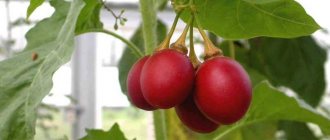Description of the Abakan pink tomato
Before purchasing salad variety seeds, gardeners try to familiarize themselves with the characteristics and description of the Abakan pink tomato variety. This must be done, because plants require proper care and suitable growing conditions.
Depending on climatic conditions and growing method, the height of the plant differs slightly. The Abakan pink tomato variety is classified as indeterminate. This is the name given to varieties of tomatoes with unlimited growth of the main stem. The majority of vegetable growers try to plant indeterminate varieties in greenhouses. In open ground, Abakan pink also produces a decent harvest, but requires certain conditions to be met.
When grown in open ground, the height parameter ranges from 1 m to 1.7 m, and in a greenhouse it reaches 2 m. The variety requires support and garter for any type of cultivation.
The plant is of medium bushiness, medium foliage, but tall. The stems are thin, the leaves are small green, and are located quite sparsely on the stem. For this reason, bushes require additional protection from direct sunlight in open ground. The bushes are not spreading, so if you follow the recommended planting scheme, you can very easily avoid thickening.
Inflorescences are formed simple with an articulated receptacle. Up to 5 full fruits ripen on one cluster; clusters are formed after 2-3 leaves.
Tomatoes of the Abakan pink variety have a medium-early ripening period.
Description of fruits
According to reviews from those who grow Abakan pink tomatoes on their plots, the fruits of the salad variety are unique.
They not only have a wonderful taste, but are also very beautiful. The tomatoes are large, heart-shaped or flat-round. The uniqueness of the variety lies in the fact that fruits of different shapes ripen on one cluster. The color of tomatoes is pink, of varying saturation, and can be light red. The skin is quite dense, and the flesh is medium dense and fleshy. Each tomato has 6 seed nests with very few seeds.
Tomatoes can be propagated using seeds collected independently - they retain their varietal characteristics. The weight of one fruit is about 300 g, and with a good agricultural background, summer residents harvest from specimens weighing 600 g each. The aroma of Abakan pink fruit is classic tomato.
Characteristics of Abakan pink tomato
The mid-early variety is grown in open ground and greenhouses. Of course, open ground is only suitable for planting in regions with warm climates. In cool climates, without shelter, yields are significantly reduced. The description of the variety contains information about the requirements of the Abakan pink tomato for growing conditions and care.
Productivity and fruiting
The variety is distinguished by long (extended) fruiting, for which it is highly valued among tomato lovers. The first fruits are ready for harvest 100-120 days after emergence. The duration of this period depends on the growing region. From 1 sq. m of planting area, 4.5-6 kg of delicious Abakan pink fruits are collected. The yield of the variety is affected by the schedule of watering and fertilizing.
Area of application of fruits
Salad large-fruited varieties of tomatoes are most suitable for fresh consumption. Abakan pink is no exception. But, besides this, it has many valuable characteristics that allow the fruits to be used for other purposes. The fleshiness of tomatoes is suitable for making paste, the juiciness and sugar content are suitable for juice, and the thick skin is suitable for preserving salads or pickling.
Resistance to diseases and pests
Thanks to its inherent characteristics, the Abakan pink tomato has good resistance to crop diseases. The variety gets sick very rarely. Therefore, vegetable growers do not have to use chemicals in the beds where the crop grows. Even invasions of the Colorado potato beetle cause much less harm to Abakan plantings than to other varieties of tomatoes.
Advantages and disadvantages of the variety
Based on feedback from farmers about the Abakan pink tomato variety, you can make a list of advantages and disadvantages. Among the positive aspects, vegetable growers highlight:
- taste characteristics;
- attractive presentation, large fruit;
- the ability to bear fruit in regions with cold climates and ripen after being picked from the bush;
- fruit resistance to cracking;
- versatility of the growing method;
- good immunity to diseases, rare cases of pest attacks;
- stable yield, extended fruiting;
- ability to endure transportation even over long distances;
- excellent responsiveness to fertilizing and compliance with agrotechnical requirements.
No pronounced deficiencies were noted in the variety, but farmers highlight:
- some difficulties of varietal agricultural technology;
- need for a garter;
- abundance and frequency of watering;
- regular stepsoning;
- short shelf life of fruits.
This is confirmed by numerous reviews and photos of Abakan pink tomatoes. The short shelf life fully compensates for the length of fruiting of the variety.
Important! During transportation, fruits are placed in containers in only one layer.
Productivity
The productivity of Abakan pink is average. When 5 kg of tomatoes are harvested per square meter, we are not talking about huge harvests. But if you consider that this is not a hybrid, the result is quite decent. The relatively low yield is compensated by extended fruiting and excellent taste of the fruit, which is why the variety is bred in principle. The yield of tomato increases with the systematic use of fertilizers:
- urea;
- potassium sulfate;
- superphosphate.
Watering affects productivity; Abakan pink responds very well to it.
Growing rules
The only way to propagate the variety is by sowing seeds. Vegetable growers collect the seeds themselves and then sow them for seedlings. When growing seedlings, they adhere to the classic technology for indeterminate tomatoes.
Planting seedlings
When growing seedlings, the main points are:
- maintaining the seed sowing period;
- competent preparation of seed material, soil and containers;
- compliance with sowing rules:
- seedling care.
Abakan pink is planted as seedlings in early March. The seeds are pre-sorted, sorting out the damaged ones. Then soak in a weak solution of potassium permanganate for 15-20 minutes. This is done for the purpose of disinfection.
Soil for seedlings can be purchased at a garden store or prepared independently from fertile soil, humus and sand. Then the prepared soil mixture is disinfected using a solution of potassium permanganate or calcination.
For sowing, take either one planting box or several separate containers. Be sure to wash with a disinfectant solution and dry.
Fill the containers with soil.
Important! The Abakan pink variety is sown in slightly compacted soil.
After sowing, the soil is moistened with a spray bottle and the containers are covered with film. Before the sprouts appear, the film is not removed, and the container is placed in a warm place.
As soon as the shoots appear, it is necessary to provide more access to the sun. Therefore, the film is removed and the seedlings are placed in a lighted place.
After the appearance of the 2nd leaf, the tomato seedlings are planted, placing the seedlings in separate containers. Many vegetable growers adhere to an important rule for growing seedlings of indeterminate varieties - double picking. Seedlings of the Abakan pink variety are prone to stretching, so this technique helps prevent this trouble. Supplemental lighting helps regulate the growth of seedlings. A week after the first planting, the seedlings are fertilized with a solution of urea (1 teaspoon per bucket of water) or the “Ideal” preparation (according to the instructions).
Tomato transplant
At the age of 60 days, Abakan pink tomato seedlings are transplanted to a permanent place. It is recommended to do this in a greenhouse at the end of April, in beds with film cover in May, and in the open sky in early June. In this case, it is necessary to take into account weather conditions. If it is decided to grow the Abakan pink variety without shelter, then the timing of planting depends on the climate of the region.
Crop rotation requirements must be taken into account. Tomatoes are not planted after or next to nightshades.
The soil in the beds is fertilized with organic matter, acidity is normalized, if necessary, deoxidized with ash or dolomite flour, and watered abundantly. All this is done a week before planting tomato seedlings.
The holes are placed at a distance of 40 cm from each other. For 1 sq. m area there should be no more than 3 plants; in the greenhouse you can increase the number to 4 bushes.
The transplant is carried out in the evening. If the tomato seedlings have nevertheless outgrown, then they need to be placed in the holes at an angle and the trunk should be sprinkled with earth.
After transplanting, water the plants well and mulch them.
Subsequent care for tomatoes
Gardeners have to pay the main attention to watering, fertilizing and forming a bush of Abakan pink tomatoes. Plants need support. High growth and overload of fruits require gartering not only of the main stem, but also of the branches. Otherwise, they can easily break under the weight of large tomatoes.
The second important factor is watering. In a greenhouse, plants are watered once every 5-6 days; when grown without shelter, they are guided by weather conditions. It is important that the water for watering tomatoes is settled and does not fall on the surface of the leaves.
When the rainy season begins, it is necessary to regularly monitor the condition of the leaves. It is at this time that the Abakan pink variety may suffer from late blight. Until the inflorescences appear, tomatoes of this variety need at least 4 liters of water per 1 square meter. m. Then the volume is gradually increased, and in the phase of fruit formation per 1 sq. m already consume 10-11 liters.
Fertilizing is very important for large-fruited tomato varieties. Therefore, you should not violate the frequency of this procedure. During the growing season, you should feed Abakan pink tomatoes 3 times and additionally do 2 foliar feedings. The first time you need nitrogen fertilizers. 10 days after planting in the ground, water the tomatoes well with herbal infusion or a solution of bird droppings.
The following nutrition is advisable before flowering and at the time of fruit set. Plants now need phosphorus and potassium. Abakan pink responds very well to potassium magnesium, urea, superphosphate and potassium sulfate. The interval between feedings should be at least 10-14 days. Infusions of wood ash, boric acid or iodine are suitable for foliar spraying. Many vegetable growers prefer ready-made mixtures so as not to harm the tomatoes. The drugs are diluted strictly according to the instructions.
Loosening and mulching significantly improve the agricultural background and reduce the burden for farmers.
Tying is mandatory when growing in open ground and greenhouses. Form Abakan into 2 stems. This makes it possible to normalize the load, grow large fruits and increase productivity. The second trunk is formed from the lower stepson under the first brush. The remaining stepsons are removed until they reach a length of 5 cm. The photo shows a large-fruited Abakan pink tomato:
How to grow seedlings
Seedlings are necessary so that in the future the plant can more easily withstand weather changes, high humidity, lack of light and other factors. Properly grown seedlings are the key to a good harvest.
Seed preparation
Be sure to treat the seed material with a solution of potassium permanganate before planting. This is necessary to disinfect the seeds and destroy pathogenic microorganisms. If you purchase seeds from a store, they should already be disinfected. However, it wouldn't hurt to do it again.
Before planting, germinate the seeds by placing them in a damp cloth or gauze. This way they will sprout faster and be ready for seedlings. However, some farmers claim that they received better yields only from dry seeds.
Container and soil
For seedlings, use soil purchased at the store. Its composition is already supplied with all the necessary substances and elements. However, many people prefer to prepare the soil for seedlings themselves. To do this, you need to add peat, humus and sawdust to the soil from the garden. The final stage of preparing land for seedlings is disinfection. A solution of hydrogen peroxide will help with this.
Almost any container is suitable for seedlings, for example, flower pots or wooden boxes. The main thing is that the container is clean and dry.
Sowing
Pour soil into the container and make small grooves about 2 cm deep. Place seeds in the grooves and sprinkle soil on top. Water the holes with plenty of warm water and place the seedlings in a bright and warm place.
Growing and care
Tomatoes are sensitive to temperature and light. Dry air makes the seedlings feel bad, so periodically spray water over them. Water the plant so as not to overwater. Never water tomatoes with tap water. For irrigation, it is better to use water from a filter.
Ventilate the room 1-2 times a day, but avoid drafts.
Important! Experienced gardeners advise providing seedlings with additional lighting, for example, using fluorescent lamps.
Don't forget about fertilizing. Organize the first one 10-15 days after the sprouts appear. Use mineral or organic fertilizers. For example, a solution based on wood ash would be an excellent option.
Pest and disease control
Among the tomato diseases that are dangerous for Abakan pink is late blight. It can attack tomatoes during wet periods of summer. Having noticed the first signs of the disease, you should immediately treat the tomatoes with a solution of copper sulfate (2%) or wood ash.
Another problem is brown rot. The disease appears when tomatoes are over-watered.
Among the pests that attack tomato plantings are the Colorado potato beetle, mole cricket, wireworm and aphid. However, the striped beetle harms the Abakan pink variety only at the stage of seedlings and unripe fruits. Therefore, before transplanting to a permanent location, it is recommended to treat the seedlings with pesticides. Other pests rarely appear on the beds of the Abakan variety.
